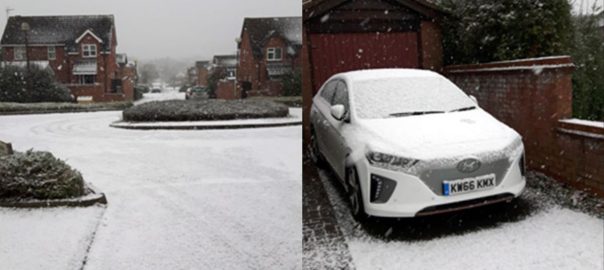Winter is not the easiest season for getting around.
Electric cars, like cars with internal combustion engines, function less efficiently in the cold. But while we accept and ignore the limitations of traditional vehicles, reports from groups like AAA misrepresent cold weather concerns about electric vehicles, fueling anxiety about vehicle range.
The reality is, electric vehicles are great winter cars.

Being realistic about range
Cold weather range is becoming less of an issue with the rapid advancement of battery technologies. Every year, electric vehicle ranges get longer.
Take my family’s experience as an example. Our first 2012 Nissan LEAF had only 73 miles of driving range. This year the same vehicle has a battery that offers a 151-mile range and in a couple of months you will be able to get a LEAF with an even bigger battery and a range of well over 200 miles. So, range is becoming less of an issue and truthfully we never had any issues with it. My wife has a 35-mile round trip commute so she could manage it even with the 2012 LEAF, but nowadays with longer range electric vehicles, things are really easy. Battery electric vehicles available in Minnesota this year have ranges between 151 to 335 miles and people who want even more flexibility in their daily driving range should choose one of the plug-in hybrids that can take you up to 640 miles. See all plug-in EV models available in Minnesota here.
Many reasons to love electric vehicles in the winter
The best part of electric vehicles for me in the wintertime is the fast heating system. Many electric cars have a heat pump heating system that works like the traditional AC, but in reverse. This system is incredibly fast in heating up the car. I tried it the first time with our 2016 Nissan LEAF. It was a typical 16 degree Minnesota winter day. I went into our cold garage and reversed the car outside to the alley. While I waited for the garage door to close I wondered why the automatic fan was already running and to my surprise it was already pushing lukewarm air from the heating ducts. I drove less than a block and the air coming out was already hot. I had never experienced this kind of heating performance from any car before.
Another rocking feature is the preheating. These cars have a preheating function that we have set up so that when my wife walks to our cold garage at 7:20 in the morning her car is waiting with a warm interior, hot seat, and even a hot steering wheel. It is a nice way to start the commute to work. Naturally I don’t recommend trying this inside a garage with an internal combustion vehicle, because the exhaust gas emissions could be lethal. This feature also mitigates the effects of cold on the range, since the bulk of the heating was done using grid power. Another perk is that you can do this anywhere you want with your phone app. Whether you are ready to leave work or a restaurant, the only thing you have to do is to take your phone and tell your car to please heat up.
Read more: Clean Technica

I read all the comments on evs and find it strange that I cannot get anywhere near these kind of figures. I put my 17 plate leaf on my three pin charger and the most I get out of it on the electric clock is 128 of course when I run the car {no heaters. no heated steering wheel} im lucky to get 100 miles out of it and that includes lots of downhill driving which includes regenerative braking so are the leafs In the usa different than here in the uk?
The Leaf is essentially the same in the USA as in the UK. The biggest factor in range is just speed, maybe you’re doing a lot of motorway driving? Drag is closely related to the square of the speed so, in theory at least, you will get 4 times the distance at 40mph as at 80mph.